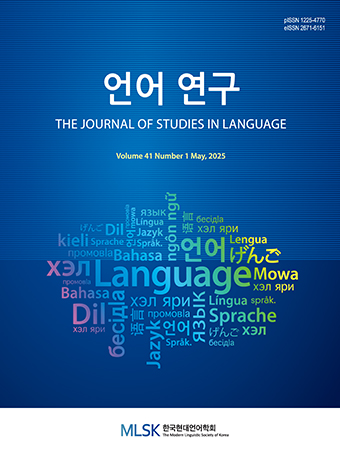Research Article
Abstract
References
Information
This paper investigates the perception and the usage of college students on the language used in social media. For this study, surveys were conducted on 110 English-speaking students and 159 Korean students. As a result of the analysis, both English and Korean students consider conversations on social media are significant. However, they also think that it is not important but indispensable. Regarding when the language used in social media is uncomfortable, both groups responded that they did not understand the meaning of the language. As for the most problematic form of language on social media, both groups responded ‘space error’ was the most problematic. Views on the language used on social media were divided for and against. However, many English respondents stated that language variations in social media texts are not severe if they do not interfere with communication. Although college students are heavy users of social media, the study found significant negative views about language variants. This can be understood that a large number of college students have a normative view used in the traditional method of language use.
- 곽면선. 2018. SNS 커뮤니케이션에서 영어와 한국어에 나타난 세대 간 언어의 격차 분석. 『언어연구』 35, 161-183. 10.18627/jslg.35.2.201908.161
- 곽면선. 2019. 영어원어민과 한국인의 모바일 텍스트 메시지에 나타나는 비언어적 커뮤니케이션 양상의 화용론적 연구: 이모티콘 사용을 중심으로. 『언어학연구』 24, 53-83. 10.21291/jkals.2019.24.1.3
- 권순희. 2001. 컴퓨터 통신 언어의 언어적 특성 고찰 . 『한국어교육학회지』 105, 143-169.
- 국립국어원. 2018. 청소년 언어실태 심층조사 및 향상 방안 연구. 국립국어원.
- 국립국어원. 2014. 2014 신어 조사 보고서. 국립국어원.
- 박선우, 박진아, 홍정의. 2015. SNS 모바일 텍스트의 언어학적 양상: 성별과 연령의 차이를 중심으로. 『현대문법연구』 82, 95-120. 10.14342/smog.2015.82.95
- 박철주. 2006. PC 통신언어 명사의 음운론적 연구. 『국어교육』 119, 457-486.
- 박현구. 2006. 온라인 문자발화환경에서 언어의 융합적 특성. 『한국소통학보』 6, 45-69.
- 배진환. 2009. 휴대전화 이용이 대인커뮤니케이션 네트워크에 미치는 영향에 대한 한․미 비교연구: 대학생집단을 중심으로. 『언론과학연구』 9, 178-210.
- 변길자. 2017. 한국어와 영어문자메시지 유형 비교 및 분석. 『언어학연구』 22.2, 71-95. 10.21291/jkals.2017.22.2.5
- 신승용. 2005. 통신언어와 국어교육. 『영남국어교육』 9, 12-26. 10.1111/j.2048-416X.2005.tb00094.x
- 윤상석, 김정은, 이동은. 2014. 모바일 메신저 대화에서 나타나는 공손 전략. 『이중언어학』 56, 155-181.
- 이옥화. 2005. 이메일이 지고 메신저가 뜬다- e러닝을 위한 제언. 『대학교육』 133, 4-67.
- 이정복. 2003. 『인터넷 통신 언어의 이해』. 서울: 월인.
- 이정복. 2011. 인터넷 통신 언어 실태와 세대 간 의사소통의 문제. 『배달말』 49, 29-69.
- 이정복. 2012. 스마트폰 시대의 통신 언어 특징과 연구 과제. 『사회언어학』 20.1, 177-211.
- 이주희, 박선우. 2012. 한국어 문자메시지의 표기와 특성: 20대 대학생을 중심으로. 『음성음운형태론연구』 18, 131-161. 10.17959/sppm.2012.18.1.131
- 이진성. 2013. 영어 통신언어의 표기 특성과 한국어 통신언어와의 의사소통 전략의 차이. 『사회언어학』 21, 221-247.
- 임규홍. 2000. 컴퓨터 통신언어에 대하여. 『배달말』 27, 23-59. 10.1080/08882746.2000.11430445
- 정일권, 김은미, 백영민. 2014. 인터넷 이용과 커뮤니케이션 규범 변화의 관계에 관한 연구. 『한국언론학보』 58, 284-313.
- 최명원. 2014. SNS 기반 온라인 메신저 의사소통의 특징적 현상 연구-한국 대학생의 단문형식 메신저(SMS) 사용에 대한 설문을 바탕으로. 『독어학』 31, 145-172.
- 천승미. 2018. 영어신조어에 대한 대학생들의 인식과 활용. 『언어학연구』 23(2), 173-197. 10.21291/jkals.2018.23.2.8
- Barker, V. 2012. A Generational Comparison of Social Networking Site Use: The Influence of Age and Social Identity. International Journal of Aging and Human Development 74, 163-189. 10.2190/AG.74.2.d 22808625
- Craig, D. 2003. Instant messaging: The language of youth literacy. The Boothe Prize Essays, 118-119.
- Crystal, D. 2008. Txting: The Gr8 Dn8, Cambridge: Cambridge University Press.
- Dansieh, S. A. 2008. SMS Testing and Its Potential Impacts on Students’ Written Communication Skills. International Journal of English Linguistics 223.1, 222-229. 10.5539/ijel.v1n2p222
- Kemp, N. and C. Bushnell. 2011. Children’s text messaging: abbreviations, input methods and links with literacy. Journal of Computer Assisted Learning 27, 18-27. 10.1111/j.1365-2729.2010.00400.x
- Thurairaj, S. and S. S. Roy. 2012. Teachers’ Emotions in ELT Material Design. International Journal of Social Science and Humanity 2, 232-236. 10.7763/IJSSH.2012.V2.101
- Thurairaj, S., E. P. Hoon, S. S. Roy, and P. W. Fong. 2015. Reflections of Students’ Language Usage in Social Networking Sites: Making or Marring Academic English. The Electronic Journal of e-Learning 13, 302-316.
- 과학기술정보통신부. 2020. 인터넷이용실태조사, www.msit.go.kr.
- 한국 갤럽. 2021. 마켓70 2021 (2) 미디어·콘텐츠·소셜 네트워크 서비스 이용률, https://www.gallup.co.kr/gallupdb/reportContent.asp?seqNo=1205.
- Chosun Biz, 2021.0616. 한국, 세계에서 두번째로 SNS 많이 한다 https://biz.chosun.com/international/international_general/ 2021/06/16/Z3VO6I2GENFENG577CH7EZWUJE/.
- Publisher :The Modern Linguistic Society of Korea
- Publisher(Ko) :한국현대언어학회
- Journal Title :The Journal of Studies in Language
- Journal Title(Ko) :언어연구
- Volume : 37
- No :3
- Pages :275-290
- DOI :https://doi.org/10.18627/jslg.37.3.202111.275




 The Journal of Studies in Language
The Journal of Studies in Language






